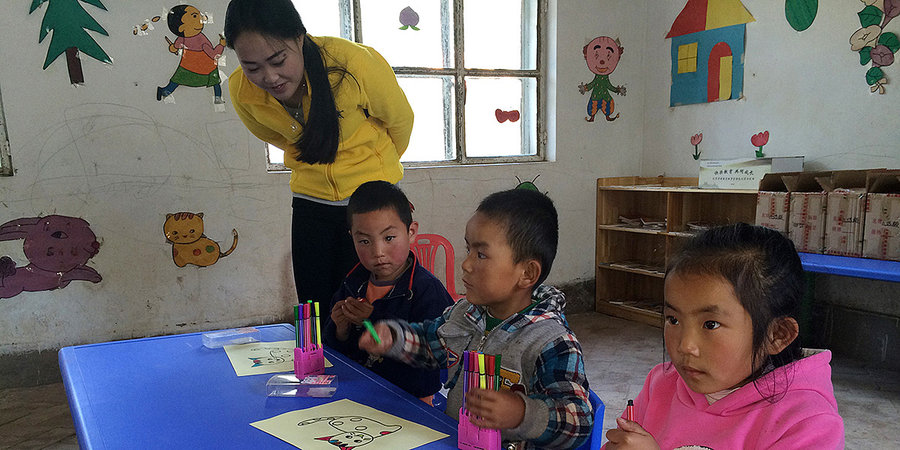【The Christian Science Monitor】 In China's remote villages, a classroom for the youngest and poorest
Without a preschool in China's mountain villages, the children of impoverished local farmers would fall further behind their city-born peers.

October 9, 2016
By Peter Ford Staff Writer
twitter@peterfordcsm
CHENGBEIHOU, CHINA
Not long ago, Guo Dekai would likely have been playing in the dirt by the side of the road with other five-year-olds, unkempt and unsupervised.
There was no preschool in this remote mountain village in western China, and every day, Dekai would have fallen a little further behind his city-born peers, his prospects a little more limited.
Instead, he is sitting in a tiny blue plastic chair alongside two other kindergarten pupils, carefully considering which felt pen to use as he colors a drawing of a cat.
The program he is in – an innovative effort to put even the poorest children in the most isolated villages through preschool – will set him up for primary school and, perhaps, a brighter future.
“There are very few kids here, so they are not as confident as city kids who grow up with a lot of classmates,” says Dekai’s teacher, Qin Haixiong. “But their skills are just the same.”How much do you know about China? Take our quiz.
Across China, now that early education is a new government priority, a spending drive means private and government-run kindergartens take care of about 70 percent of preschool-age children.
But Chengbeihou and villages like it are 9,000 feet up in the mountains of Qinghai province, several hours’ drive from the nearest town. They are beyond the reach of the government preschool network, and no private school would bother with them; the peasant farmers who live here raise meager crops of barley and potatoes and are too poor to pay fees.
Closing the gap with cities
About 16 million Chinese youngsters between the ages of 3 and 6 are not enrolled in kindergarten. “And these are not rich kids who have babysitters,” says Lu Mai, head of the China Development Research Foundation, a Beijing-based think-and-do tank. Rather, they live in China’s most distant, hardscrabble villages.
The foundation, a government-linked group funded largely by foreign and Chinese corporations, is behind the Village Early Education Centers (VEECs), a pilot plan that Dekai and about 25,000 other children benefit from.
The project is deliberately aimed at the poorest 20 percent of Chinese children because “lack of access to preschools in remote villages further widens the existing gap in … school readiness between poverty regions and peri-urban and urban areas,” says a 2015 progress report on the seven-year-old effort.
In a bid to level the playing field for China’s youngest students, “we started this work from an equity perspective,” adds Mr. Lu. And in making its plans the foundation drew on such diverse sources as the US Head Start program and the barefoot doctors and horseback teachers of China’s Maoist era.
One key goal of the VEECs was that they should be free. To keep costs down, they have been set up in disused primary schools that have emptied of children as more and more peasant families have joined the rural exodus in search of city jobs.
Parents see a difference
Ms. Qin, Chengbeihou’s kindergarten teacher, grew up here. When she was a child, she recalls, there was no preschool, but the primary school crammed 200 children into its six classrooms. Today she uses one of those rooms to teach just four preschoolers, and there is only one primary-school-age child in the village.
Vivacious and enthusiastic, Qin is typical of many of the teachers hired by the VEECs: local women in their early 20s, fresh out of teacher training. They are paid $250 a month, a third of what a fully fledged government-employed teacher gets, but there are few such jobs available.
Instead, most state-employed teachers in the countryside are given only temporary contracts that pay just $70 a month; a job at a VEEC is a significant step up, and also offers the opportunity for continuous training.
The difference these young teachers make is striking, says Guo Qiang, an illiterate peasant farmer in the nearby village of Jiujiashan who has put his two sons in the local early education center.“They are much cleaner and they behave better at table,” says Mr. Guo. “Teacher tells them to take care of their things and themselves and they do. I can’t read, but I know my elder boy is doing well at his tests. Maybe if he is smart enough he could get a good job; he likes playing with his police car and says he’d like to drive one when he grows up.”
Next challenge: Scale it up
Wang Shengguo, the veteran primary school headmaster in Yahe, another mountain village, notices the difference, too. “In the past, kids coming into primary school knew much less than the kids coming out of kindergarten now,” he says. “They are more disciplined and they act in a more civilized way.”
That makes them easier to teach, Mr. Wang says. “Their test scores are much higher than they used to be,” he notes. “Kids used to get 40 to 50 percent. Now they get 80 to 90 percent. That’s about what urban kids get.”
That success is reflected in the results of an independent study last year, which found that children attending VEECs had the same levels of cognitive development as children in urban government-run kindergartens, and that their social behavior, emotional expression, and self-regulation scores were even better. All for about $5,000 a year per school.
The next task, says foundation head Lu Mai, is to convince the national
government to scale his experiment up from the pilot stage, to bring its
benefits to millions of children instead of tens of thousands. “To cut the
generation-to-generation chain of poverty we need to start with early child
development,” he says. “We have shown it can be done.”




